Newsletter November 2022
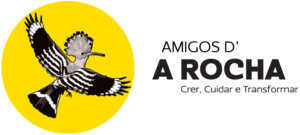
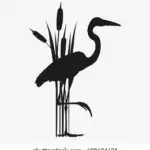
Happy 5th Birthday Friends of A Rocha
This month discover the large white bird and the small pink flower.
Helen & Filipa
S
N
A
P
SHOT

Branca Edmée Marques

Portuguese Chemist Scientist
Born: 14th April, 1899, Lisbon
Died: 19th Jully, 1986, Lisbon
Branca Edmée Marques was born in Lisbon, Portugal; her childhood was marked by the death of her father when she was only eight years old; her mother took care of her further education. After finishing the secondary school she enrolled at the Faculty of Sciences at the University of Lisbon to study Chemistry and Physics; Branca had the highest marks in all the subjects and was invited to be a chemistry assistant in 1924 (one year before graduating), becoming the first and only women (at the time) to work at the University’s Laboratory of Chemistry.
In 1930, Branca requested a scholarship to study abroad, which was awarded in November 1931, by then she left to work in France at the Laboratory Marie Curie doing research in nuclear physics and radioactivity under the supervision of Marie Curie. In 1935, after Marie Curie’s death she earned her Phd degree by the Sorbonne University with the thesis New research on the fragmentation of radiferous barium salts. Back in Portugal her doctorate degree was recognised by the Portuguese University. In 1936, Branca establishes the first research laboratory in Chemistry at the Faculty of Sciences in Lisbon.
During her life she did research in nuclear chemistry, radiochemistry and in therapeutic application of radioisotopes; she published several articles and was assistant professor at the University of Lisbon from 1942. It was in 1966 that she was finally awarded the position of full professorship, becoming the first woman in Portugal to have a full professorship in Chemistry
IFO’s – Identified Flying Objects…
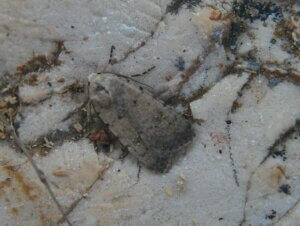
Pale Mottled Willow
(Caradrina clavipalpis, Scopoli, 1763)

Morphology: It is a macro moth from the Noctuidae Family, with a wingspan between 26 and 35 mm. The forewings ground colour varies from pale yellowish to grey-brown, shows a distinct mottling with 3 to 4 small dots along the costa (leading edge); has a kidney mark usually darker than the ground colour and a pale sub terminal line. The hindwings are whitish with a grey terminal band. The adults fly from April to October (depending on the location).
Habitat: Grasslands, shrub land, open woodland and gardens.
Distribution: Europe, North Africa and parts of Asia.
Notes: The larvae is polyphagous and feeds on several grasses, like Plantago sp and various cereal crops. This species was introduced in North America, first recorded in 1993 seems to be spreading.
Tweet… Tweet…

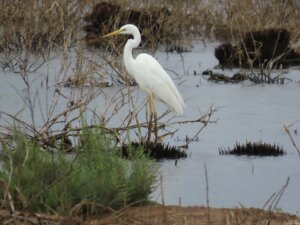
Great Egrett
(Egretta alba, Linnaeus, 1758)
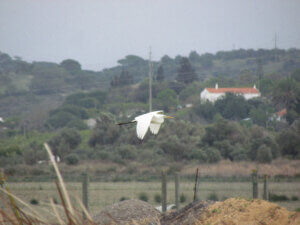
Photos by Guillaume Réthoré
Identification: It is a large egret from the Ardeidae Family, it is 85 to 100 cm long and has a wingspan between 145 and 170 cm. The plumage is entirely white, the bill is yellow and the legs are dark (out of the breeding season); during the breeding season the bill gets more dark and yellow just close to the lore’s and the legs get yellowish). Very similar to Little Egret (Egretta garzetta), but larger. More elegant with longer legs and neck. Females and males are alike.
Habitat and Ecology: Breeds in colonies in swamps or shallow lakes, in reed beds and wetlands with some trees. The diet consists of fish, frogs and other amphibians, small mammals, occasionally crustaceans and insects (this species impales their prey with its long and sharp bill).
Distribution: Worldwide distribution: Europe, Africa, America, Asia and Oceania. In Portugal in the past (until the end of 1990) used to be a rare species, nowadays is more common and can be seen in some wetland areas especially during winter.
Threats and Notes: Least Concern (LC) according to the Red List of the International Union for Conservation of Nature (IUCN). The overall trend population is unknown, some populations seems to be decreasing while others are increasing.
DID YOU KNOW? 
- One of our volunteers at A Rocha has kindly been lent a bicycle by Marco Ramos of TIK TAK bike tours & rentals of Alvor. Marco is very involved with a community cycling project in partnership with the Portimão Council. This is designed to help young people by providing bicycles, giving cycling courses, bicycle repair training and much more. He is now helping us – thank you Marco!
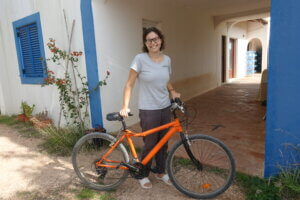
- Friends of A Rocha Portugal were once more at Sagres Bird Festival! It was a lovely event and a special thanks to all the volunteers who helped at A Rocha Portugal’s stand.
- For the first time A Rocha Portugal were invited to have a stand at the Better Living in Portugal (BLiP) exhibition in Portimão. During the event we gave people the opportunity to participate in a lucky draw. The draw took place on Thursday 13th October at Cruzinha and there were ten lucky winners, all will receive a year’s free membership starting this month – CONGRATULATIONS !
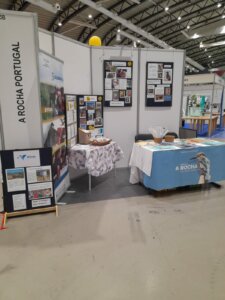
Friends of a Rocha stand at BLIP
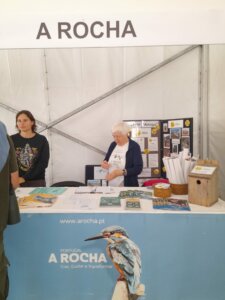
Friends of a Rocha stand at Sagres Birdwatching Festival
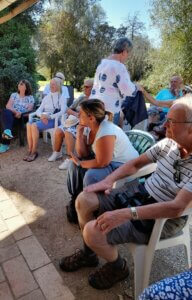
Lucky draw at Cruzinha
-
This year, once more we had the visit and help of Heather Coats, for one more autumn ringing season! During this period there were some very interesting birds caught, like the European Nightjar (Caprumulgus europaeus), Western Subalpine Warbler (Curruca cantilans), Common Snipe (Gallinago gallinago), and some more common birds, Blackcap (Sylvia atricapilla), Common Chiffchaff (Phylloscopus collybita), European Robin (Erithacus rubeculla).
- On the 6th November A Rocha will take part in the Walk & Art Festival, guiding 2 birdwatching walks! Join us and meet the birds of mata de Barão de São João. More information here
-
On the 23rd of November join us for our last amazing Friends Event! More information later in the newsletter.
Friends Event – 23rd November: Recycling Craft Event with Christmas in mind
This creative recycling Christmassy craft event was requested by members after their experience at the first Event given by Elisabete earlier this year.
It will be held at Cruzinha, starting at 10.30,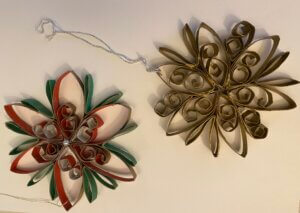
‘ Angels & snowflakes’ will then be created all ready for your festive season.
Lunch will be served at 13.00 and the day should finish about 14.30.
Ticket price:
Friends – €20 Non- friends – €25
 INVASIVE SPECIES
INVASIVE SPECIES
Northern Raccoon (Procyon lotor, Linnaeus, 1758)
Phylum: Chordata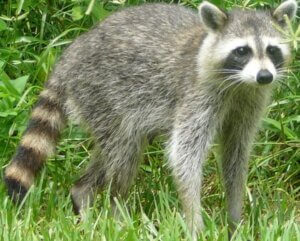
Class: Mammalia
Order: Carnivora
Family: Procyonidae
Origin: Central and North America
Size: 75 to 100 cm
The Raccoon is a medium-sized carnivore with stocky body and short limbs. The pelage is dark grey with a black mask and ringed (black and white) tail; on the shoulders and back the plumage is reddish-brown, however pelage colour variation is quite common (black, orange, cinnamon according to the distribution. The face is white and it has check tufts which gives the impression of a broad head. The spine is curved giving the animal a rounded appearance similar to a bear. Females and males are alike in colour but males are usually larger in body measurements and weight.
This species is native to Central and North America and has a widespread distribution (from Panama to Canada and Alaska). The Northern Raccoon has been introduced in some Caribbean Islands, eastern and Western Europe and also in some parts of Japan. Occurs in a wide range of habitats, usually associated with water (woodlands, wetlands, farmlands and urban landscapes). The diet is omnivorous and opportunistic, feeding according to the availability of food items; plants are an important part of its diet (acorns, grain crops), but as well eggs, nestlings, insects, worms, small mammals, aquatic invertebrates and garbage. Usually sleeps during the day and is active during the night. Typically solitary, except the female when it has young.
Raccoons are widely used in the pet trade and fur market and are bred in captivity in some European countries; these can lead to accidental escapes or even to intentional releases (for hunting). This species was first recorded in Europe in 1927 (Germany) and its numbers increased in the last decades; it is already widespread in 27 European countries and is considered one of the 100 worst invasive species. There are already some populations established in Spain but it has not happened in Portugal yet.
POPPED UP
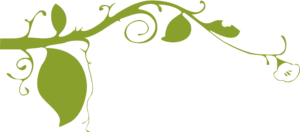
Family: Colchicaceae
Identification: It is a perennial herbaceous plant, grows from a bulb with 4 to 6 cm height. The leaves are linear, long and narrow growing just after the flowers; the flowers are lonely, small pink to purple, the petals are long and narrow. The fruit is a small oblong capsule. Flowers from October to November.
Habitat and distribution: Grasslands, fallow lands, shrub land clearings and acid soils. Native from the West Mediterranean.
Notes: The flower emerges directly from the ground generally in groups which form beautiful pink carpets. This plant is dormant during the summer (the bulb remains in the soil).
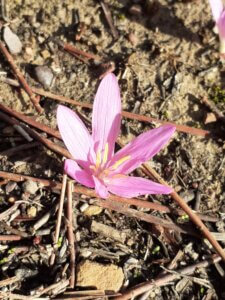
Autumn crocus (Merendera filifolia, Cambess.)
DATES TO REMEMBER

1st of November – Public Holiday All Saints Day, Anniversary of the day that Mexilhoeira Grande became a village (1999)
4th to 6th November – Walk & Art Fest, Barão de São João. More information here
3rd, 10th, 17th, and 24th November – Cruzinha Bird ringing display & Moth Talk (10 am to 12:30). Book here
23rd November – Friends Event: Recycling Craft Event with Christmas in mind & Lunch (please book your place)
Thank you for supporting the Friends of A Rocha Portugal

Physiotherapy, Massages (relaxation, sports, therapeutic)
Other therapies
Beauty (manicure, pedicure, hair removal, facials)
Open Monday to Friday
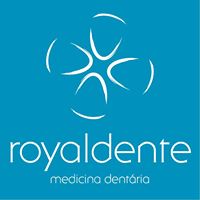
Dr Roy Rodrigues
Av. Do Brasil, Qta das Palmeiras, Lt P2, R/c A, 8500-299 Portimão
(+351) 282180683
royaldente@gmail.com
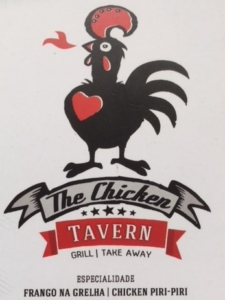
Urbanização Mar e Serra n° 47, Alvor
8500 – 783 Portimão
(+351) 911597735
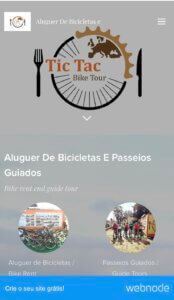
Thought of the month 
You cannot get through a single day without having an impact on the world around you. What you do makes a difference and you have to decide what kind of a difference you want to make.” —Jane Goodall ( English Primatologist and Anthropologist, famous for her work in Africa with Chimpanzees)
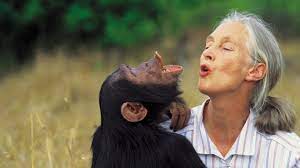
LETS BE GREEN – LETS BE GREEN – LETS BE GREEN 
House Plants & Air quality at home
- We spend 90% of our time indoors each year on average, which makes the need for clean air even more important.

Anthurium
- According to the World Health Organisation, 3.8 million deaths are attributed to household air pollution annually.
- Indoor air pollutants include mould, building materials, home products, volatile organic compounds (VOC’s) and naturally occurring gasses like Radon.
- By introducing plants into our households, we could help to reduce the amount of CO2 in the air, head towards easier breathing and improve our overall health.
- The top 5 house plants for absorbing CO2 are the Prayer Plant, Rubber Plant, Birds Nest Fern, Dieffenbachia and Anthurium.
LETS BE GREEN – LETS BE GREEN – LETS BE GREEN
Otter’s project
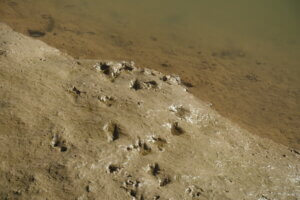 As an ESC volunteer at A Rocha Portugal, I had the opportunity to choose a personal project, which I would work on throughout the year. I decided to do an otter’s survey, since the last otter’s survey was done in 2015. I divided my field work to 6 days per mouth, according to different transects, which are spread around Ria de Alvor ( Abicada, Quinta da Rocha, Meia praia and Alvor). Otters are nocturnal animals, which means they are active more during the night. That’s the reason why, my field work starts
As an ESC volunteer at A Rocha Portugal, I had the opportunity to choose a personal project, which I would work on throughout the year. I decided to do an otter’s survey, since the last otter’s survey was done in 2015. I divided my field work to 6 days per mouth, according to different transects, which are spread around Ria de Alvor ( Abicada, Quinta da Rocha, Meia praia and Alvor). Otters are nocturnal animals, which means they are active more during the night. That’s the reason why, my field work starts  early in the morning at low tide. I cycle to a specific location and then walk on transect around 5 km. Sadly, otters are very shy animals and I haven’t been able to see one. To confirm their presence on certain location, I search for their footprints and spraints. I’m also using a trap camera to concur their presence. So far, the trap camera hasn’t recorded one otter, but I recently got a nice video of common genet (Geneta geneta) on Abicada.
early in the morning at low tide. I cycle to a specific location and then walk on transect around 5 km. Sadly, otters are very shy animals and I haven’t been able to see one. To confirm their presence on certain location, I search for their footprints and spraints. I’m also using a trap camera to concur their presence. So far, the trap camera hasn’t recorded one otter, but I recently got a nice video of common genet (Geneta geneta) on Abicada.
Dasha Stalk (see newsletter april 22)
Climate change – Real Facts
Artic sea ice reached the 10th minimum extent from the last 44 years.
“Each year, Arctic sea ice melts through the warmer spring and summer months and usually reaches its minimum extent in September. As cooler weather and winter darkness sets in, the ice will grow again and reach its maximum extent around March.” From NASA
Global warming from 1880 to 2021
Global temperatures in 2021 were 0, 85° C higher than the average. The past eight years were the warmest since 1880.
Sustainability Champions 
Sustainability Champions from around the World
We would like to thank Daniel Hartz, the founder of Sustainability Champions for giving us the permission to share this information.
Looking at ways to curb pollution and waste management.
Scientists at NTU Singapore have invented biodegradable paper-thin zinc batteries, that can be bent or cut without losing its function. They hope that one day they will be used to to power flexible and wearable electronic systems while also being environmentally friendly.
 Electrodes (through which electrical current leaves or enters the battery) are screen=printed on both sides of cellulose paper that has been strengthened with hydrogel in these zinc batteries.
Electrodes (through which electrical current leaves or enters the battery) are screen=printed on both sides of cellulose paper that has been strengthened with hydrogel in these zinc batteries.
When the battery is depleted, it can be buried in the ground, where it will degrade completely within a month.
Assistant Professor Lee Seok Woo of NTU School of Electrical and Electronic Engineering, who is the study’s co-leader believes that the paper battery could have the potential to help with electronic waste problem. Given that the printed paper battery is non-toxic and does not require aluminium or plastic casings to encapsulate the battery components.
These batteries are a step forward from current Li-ion batteries that are widely utilized. The researchers believe their printed battery might be used in flexible electronics like foldable smart phones, which are already on the market, or biomedical sensors for health monitoring.

Check the website for dates for organised tours
Guillaume Réthoré (Gui)- My life with birds: Red Knot (Calidris canutus)
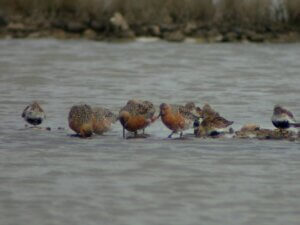
Waders are considered as a difficult group of birds by some birdwatchers. It is true that in winter, most of them are grey or brown without any colour. In spring, in their breeding plumage, they are beautiful!
As part of my Master i studied the migration of Red Knots (Calidris canutus) in Western France. I got the chance to see thousands of them and most of them in breeding plumage. On the picture, it is possible to see 5 Red Knots, the bigger birds, with their rusty-coloured breeding plumage and 5 Dunlin (Calidris alpina), easily recognizable with the dark patch on their belly.
That work confirmed my interest for waders and nowadays I still enjoy doing wader counts at Ria de Alvor.
Text and photo by Guillaume Réthoré
Editor: Filipa Bragança
English proof reading: Helen Rodda
Portuguese proof reading: Lena Soares
Production controller: Helen Rodda
Email: friends.arpt@arocha.org
Thank you for supporting us!
Hope to see you soon!


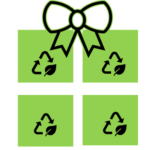 What makes a good Birthday present?
What makes a good Birthday present?


